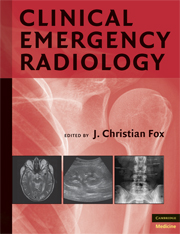Book contents
- Frontmatter
- Contents
- Contributors
- PART I PLAIN RADIOGRAPHY
- PART II ULTRASOUND
- PART III COMPUTED TOMOGRAPHY
- 28 CT in the ED: Special Considerations
- 29 CT of the Spine
- 30 CT Imaging of the Head
- 31 CT Imaging of the Face
- 32 CT of the Chest
- 33 CT of the Abdomen and Pelvis
- 34 CT Angiography of the Chest
- 35 CT Angiography of the Abdominal Vasculature
- 36 CT Angiography of the Head and Neck
- 37 CT Angiography of the Extremities
- PART IV MAGNETIC RESONANCE IMAGING
- Index
- Plate Section
31 - CT Imaging of the Face
from PART III - COMPUTED TOMOGRAPHY
Published online by Cambridge University Press: 07 December 2009
- Frontmatter
- Contents
- Contributors
- PART I PLAIN RADIOGRAPHY
- PART II ULTRASOUND
- PART III COMPUTED TOMOGRAPHY
- 28 CT in the ED: Special Considerations
- 29 CT of the Spine
- 30 CT Imaging of the Head
- 31 CT Imaging of the Face
- 32 CT of the Chest
- 33 CT of the Abdomen and Pelvis
- 34 CT Angiography of the Chest
- 35 CT Angiography of the Abdominal Vasculature
- 36 CT Angiography of the Head and Neck
- 37 CT Angiography of the Extremities
- PART IV MAGNETIC RESONANCE IMAGING
- Index
- Plate Section
Summary
CT has surpassed plain film radiography as the method of choice for rapid and efficient facial fracture identification in the multitrauma patient and the patient with isolated injuries to the face. One key reason is that plain film radiography facial views, such as the Waters' view, require repositioning to overcome the problem of overlapping structures obscuring fracture assessment. This is problematic because trauma patients often arrive with a rigid cervical collar in place. CT bypasses this problem and allows for simultaneous evaluation of facial trauma during emergent assessment for intracranial and cervical spine injury. CT images depict all areas of the facial skeleton without the need for repositioning, allow for accurate identification of exact bones involved in a facial fracture, and provide detail into the degree of fracture displacement and the extent of soft tissue involvement. 3D images constructed from CT images are also useful to direct presurgical planning. The qualities listed here make CT the preferred diagnostic tool in suspected fractures involving the thin bones of the orbit and midface. CT is also preferred for multitrauma patients exhibiting clinical signs of orbital involvement and when soft tissue swelling prevents adequate clinical assessment (1–4).
In the multitrauma patient, a head CT is routinely performed to screen for intracranial injury.
Keywords
- Type
- Chapter
- Information
- Clinical Emergency Radiology , pp. 438 - 456Publisher: Cambridge University PressPrint publication year: 2008

